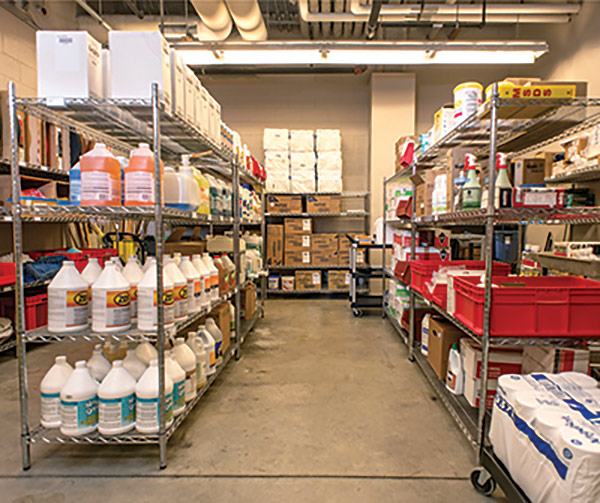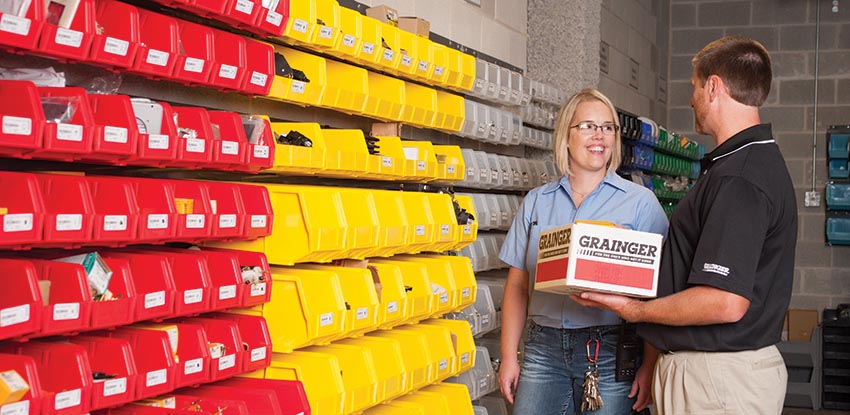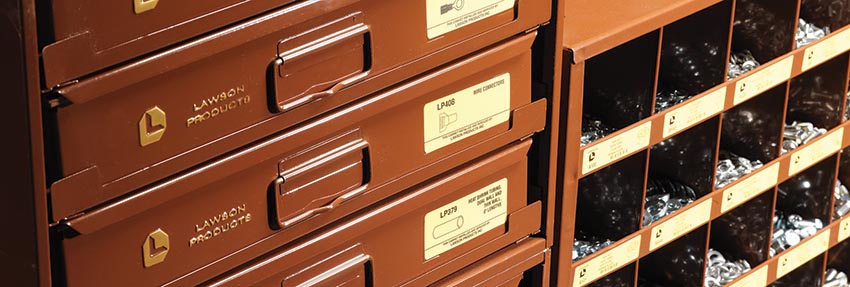Maintenance Repair and Operations (MRO) Consumables: Where the web and People Work Together
Consumables, a critical but not glamorous player in the MRO world, are a curious mix of advanced e-commerce and old-school people skills on the facility floor. The two are meshing in an extraordinary way and making operations more efficient and cost effective.

MRO consumables don’t get nearly as much respect as they should. A glove is seen as just a glove. A fastener is just a fastener. And, a lubricant is a lubricant.
Perhaps just as important, a consumable is not typically high value. Michael DeCata, president and CEO of Lawson Products, tells the story of one of his company’s largest customers—a $4 million account. A review of what the company bought last year came down to this:
- The average piece price was $0.94.
- The average piece price of the 100 most expensive items was $3.54.
- And, the average piece price of the 100 largest volume products was $0.11.
Talk about not high value. Until, of course, the right consumable is not available when it’s needed.
That might mean it’s in the facility but not immediately findable. Or, worse yet, there isn’t so much as a single one of the much-needed piece in the facility. In fact, Grainger says that technicians leave MRO consumable storage areas without the proper item or quantity more than 20% of the time.
Not only are these conditions a huge time waste for technicians, but who knows what equipment will not be up and running with minimal interruption for lack of an $0.11 part?
There’s some real money at stake here. Industry estimates put the entire industrial distribution market at roughly $125 billion plus annually. Consumables are a niche of that at $20 billion to $25 billion.
It’s also highly fragmented with the three largest distributors accounting for roughly 15% of the total market. Other players include some other sizable distributors, but “mom-and-pop” distributors dominate the industry. It’s also worth noting there’s a new entrant making a mark these days—Amazon Business.
As would be expected in the age of e-commerce, suppliers are making major strides in the buying process. “But this is not just a buy/sell relationship,” says Kevin Hartler, Grainger’s senior director of consulting services. There’s also the matter of replenishment.
This means distributors are working closely with shop and warehouse managers to ensure the right parts are in the right place at the right time without allowing inventory levels on site to exceed reasonable levels. “What we’re after is a good customer experience that lets them get back to doing the rest of their job as soon as possible,” Hartler says.
And the power to make that happen often rests with distributor reps, not digital systems, handling consumables in the facility where they are consumed.

The growing power of e-commerce
On the buy/sell side, e-commerce continues to grow rapidly. DG Macpherson, CEO at Grainger, projects that by 2022, a full 80% of the company’s sales will be online. Last year, more than 65% of Grainger’s orders came through a digital channel.
Amazon is doing nothing to diminish that trend. “We heard from business customers that they love the convenience of shopping online and want an experience at work that is similar to how they shop at home,” says an Amazon spokesperson.
It’s worth noting that Amazon Business is the company’s complete business-to-business marketplace. Beyond MRO consumables, its offerings cut across commercial, government, education and health care.
That said, Amazon recently announced that it “now has more than one million business customers since launching in April of 2015, offering business-only pricing on millions of products and access to more than 85,000 business sellers.”
Amazon Business says a unique feature of its site is the multi-seller marketplace. Here, “business customers can view multiple offers on a single product page for easy price comparisons, as well as shop sellers that consistently meet the performance and service requirement that businesses expect,” adds the Amazon spokesperson.
That online presence is not being overlooked by others. This summer, Grainger released its new site, gamut.com. The company describes it as “a new e-commerce capability designed to provide useful information to industrial professionals seeking time-saving solutions for challenging projects.” You can find more than 400,000 products on the site.
The combination of e-commerce and ease of buying is proving to be powerful in MRO consumables. It’s not uncommon for distributor transactions to tie in directly to customers’ procurement systems.
Five top safety questions about MRO consumables
- Can you explain the different classes and types of first aid kits under the revised ANSI/ISEA standard?
- What gloves are appropriate for protection from acid?
- What does the date stamp on my electrical rated rubber insulating gloves mean?
- Do I need leather protector gloves over my electrical-rated, rubber insulating gloves? If so, what length glove should I get?
- What are the secondary container labeling requirements under the GHS standard?
Managing inventory
“Ideally, the customer would like to forget about MRO consumables. They would all love to have their bins full of all the right items all the time,” says DeCata of Lawson.
And when distributors say “full,” they mean really full. “Companies tend to purchase more than they need,” says Hartler.
In fact, Grainger says up to 60% of on-hand MRO stock inventory exceeds a one-year supply.

More than 100,000 vending machines (left) are installed, managing inventory and tracking who takes what items. Vertical lift modules (right) are a relatively new storage device well suited to slower-moving items.
Furthermore, there’s the problem of being able to find stock in the first place. “If people can’t find it, then the answer is to buy more,” Hartler adds.
As a rule of thumb, distributors say they can reduce stock levels 25% by asking three questions: Why is the inventory required? How is it used? And, when is inventory used?
This determines when inventory is needed and stocked accordingly. It eliminates traditional min/max gauges and bases replenishment on actual usage patterns.
Hartler describes three levels of inventory management. The most basic is what he calls a stocked environment. This is when a company doesn’t track levels closely, but it knows they have “plenty of stuff, but not enough process.” A managed environment is the next level where inventory is managed with adequate process. The top level is a leveraged environment. Here, the company mixes inventory and process with data analytics to more accurately manage the flow of consumables through the facility.
There is a three-level hierarchy of value in these programs, says DeCata.
At the base of the triangle is replenishment services for consumables that is optimized for the application. The next level up is consultative problem solving. There is less call for this, he says, but the service provides high value. At the top of the pyramid is teaching customers about new consumable technology that can add value to their operations.
Distributors work with customers through their consulting services and vendor-managed inventory (VMI) programs. For instance, Grainger VMI is known as GMI and Lawson’s is LMI. Typically, the distributor actively manages the inventory at every stage. Consulting services run from designing the stock room to reordering and weekly visits by distributor reps to unpack shipments from their boxes and putaway in bins, shelves, cabinets and vending machines.

Finding stock in the first place is often a challenge unless a structured process is in place to ensure people can find the consumable they need when they need it.
For more than 20 years, vending machines have been an important part of MRO consumables. One company, AutoCrib, supplies vending machines but not consumables. The large distributors typically supply product and vending machines. More than 100,000 of the machines are in place today.
Stephen Pixley, president of AutoCrib, describes the equipment as “a complete tool and supply control system.” That said, there are two leading uses for the machines.
A leading one is consumption reduction. “By putting items in vending machines, a company can minimize waste, fraud and abuse right off the top,” says Pixley. Product is placed in the machines and secured until an authorized person accesses it, making a record of who took what from the machine. Consumption reductions of 20% to 40% are common, says Pixley.
There is also the matter of increasing workers’ efficiency on the facility floor. Vending machines are highly effective at managing resources so people return to the task at hand as quickly as possible, increasing their on-the-job efficiency.
Typically, says Pixley, a vending machine pays for itself in six months. About 80% of vending machines operate as VMI. Some bill on restock. Others bill when an item is removed from the machine.
AutoCrib is using a different storage technology alongside its vending machines—vertical lift modules. They are best suited to slower moving inventory that requires an attendant to manage the stock.
To the next generation
Clearly, MRO consumables are at an interesting nexus between advanced e-commerce without people and VMI with plenty of people power. It’s almost a mix of two quite different generations of getting work done. And while other industries are going through a similar passage, few see people power continuing to be a strong force going forward. That’s not the case here.
What’s just as interesting is the mix of the Web and people to pass on knowledge from experienced people to those newer to the business.
Most companies use training and seminars. Lawson also uses, of all things, social media, says DeCata. With the new collaboration application “Microsoft Teams,” Lawson sales representatives use their mobile phones to post questions and get answers from knowledgeable colleagues in real time.
DeCata says it’s a modern way to pass on knowledge from a workforce with a high experience level to one with less. “It may be happening online, but in many ways it’s not a whole lot different than the car conversations between retiring and newbie reps in 1985,” he adds.
And in many ways, that social media approach is the epitome of the new school and old school changes that MRO consumables are experiencing today.
Companies mentioned in this article

Article Topics
MRO News & Resources
Avidbots showcases autonomous cleaning robots Traka exhibits modular lockers MRO Survey: Finding and keeping the best technicians Maintenance, Repair and Operations: Understanding the true condition of the equipment Newly formed Bison combines AMETEK DFS and Bison Gear and Engineering Corp. Building (and maintaining) your maintenance, repair and operations (MRO) tech workforce The power side of lift truck battery and charger maintenance More MROLatest in Materials Handling
The (Not So) Secret Weapons: How Key Cabinets and Asset Management Lockers Are Changing Supply Chain Operations MODEX C-Suite Interview with Harold Vanasse: The perfect blend of automation and sustainability Consultant and industry leader John M. Hill passes on at age 86 Registration open for Pack Expo International 2024 Walmart chooses Swisslog AS/RS and software for third milk processing facility NetLogistik partners with Vuzix subsidiary Moviynt to offer mobility solutions for warehouses Materials Handling Robotics: The new world of heterogeneous robotic integration More Materials HandlingSubscribe to Materials Handling Magazine

Find out what the world's most innovative companies are doing to improve productivity in their plants and distribution centers.
Start your FREE subscription today.
April 2024 Modern Materials Handling

Latest Resources










